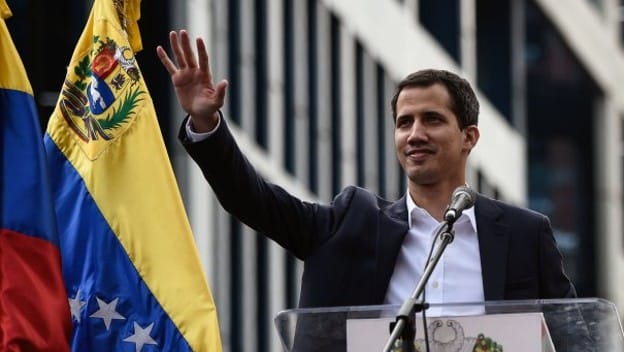
Why the new protests in Venezuela are different
Thousands of Venezuelans took to the streets on Wednesday to confront Nicolás Maduro and the Western Hemisphere’s most wantonly destructive regime. A resurgent opposition — under the leadership of Juan Guaidó, the until-recently unknown 35-year-old leader of Congress and now the self-declared president of Venezuela — has mobilized its supporters to try to dislodge what’s now a no-doubts-about-it dictatorship.
On Wednesday afternoon Guaidó claimed to be the legitimate leader of Venezuela, directly challenging Maduro’s authority. President Trump promptly recognized Guaidó as Venezuela’s interim president.
“In its role as the only legitimate branch of government duly elected by the Venezuelan people, the National Assembly invoked the country’s constitution to declare Nicolas Maduro illegitimate, and the office of the presidency therefore vacant,» Trump said in a statement. «The people of Venezuela have courageously spoken out against Maduro and his regime and demanded freedom and the rule of law.”
Opponents of the regime have launched demonstrations across Venezuela for the first time in months. Fear of repression and a mass exodus of young people amid severe food and medicine shortages had paralyzed the movement against Maduro as he made moves to consolidate power.
The mass migration of, by some counts, 3 million Venezuelans who have set off for neighboring countries is top-heavy with the protest generation that led the insurrections of 2017, and 2014 before them. Rather than lobbing molotov cocktails at the security services, they are now waiting tables in Colombia, staffing call centers in Peru or working construction jobs in Ecuador. At recent protest rallies in Venezuela, it has been impossible to miss the proliferation of graying heads: It’s the parents of the stone-throwing protesters of yesteryear who are on the front lines now. Their fight, now, is to build a country that their children might want to move back to.
On Monday and Tuesday night, though, the focus of protests shifted from the impoverished parents of better-educated migrants to Venezuela’s now desperate working class. After a small attempted rebellion by a couple of dozen of National Guard troops failed, nighttime pot-banging protests began to break out all over Caracas, and small groups of protesters spilled out onto street corners, setting piles of garbage on fire and manning makeshift barricades.
Venezuela has seen protests like these many times before, but this week’s are different. For years, such protests were concentrated in middle-class enclaves in Caracas and other big cities. Working-class people stayed well away from them, allowing the self-described socialist government to portray the protests as a kind of middle-class tantrum over lost privileges.
This week, though, nighttime protests lit up working-class areas throughout Caracas’s most reliably pro-government areas — while middle-class protest hot spots were quiet. An unusual inversion of the city’s protest geography is underway — though, again, not so unusual when you consider how many of yesteryear’s middle-class protesters have simply given up and left the country.
The protests this time around are different. No one in Venezuela is under any illusions about the government any longer. Its ghastly record of violence against dissidents is now firmly established, its absolute lack of scruples about what it will do to stay in power clear in every mind.
The regime, which once peddled itself as an alternative model of development for working people worldwide, is virtually out of international supporters. After his artlessly rigged reelection last year,Maduro’s second inauguration this month was snubbed by almost everyone, except for a rogue’s gallery of authoritarian regimes who sent representatives: Cuba, Russia, Turkey, Nicaragua, Bolivia and, tellingly, South Ossetia — a secessionist shard of Georgia recognized by no one outside Vladimir Putin’s sphere of influence.
The Lima Group, a 14-country coalition of Western Hemisphere democracies headed by Peru and Canada, has led an aggressive diplomatic push against the regime. Venezuela’s two large neighbors — Colombia and Brazil — now both actively call out the Maduro regime as a dictatorship that must leave power. The United States, too, has become more assertive, with Vice President Pence and Sen. Marco Rubio (R-Fla.,) driving an increasingly hard line against the Maduro regime and talk of cutting off vital oil sales to the United States increasingly on the agenda.
All the regime has left on its side is violence — and fear: In 2017, repression left 136 dead, and thousands were tear-gassed, jailed or tortured. Its increasingly naked dependence on repression to hold its grip on power has become at once its last source of strength, and its most obvious vulnerability.
The opposition’s new leader, Guaidó, is now directly challenging Maduro’s legitimacy and addressing the men and women in uniform, promising amnesty to those who help push out the regime and vowing respect and deference to those who take a stand for the battered democratic constitution.
Venezuela has spent the past 20 years in an increasingly dramatic tailspin into dictatorship and societal collapse. Those of us who have called for its democratic renewal have had our hearts broken one time too many to really allow ourselves to believe in new dawns again. A traumatized nation, now fractured between those who have remained and those who fled, can hardly muster up the courage to hope again. Much could still go wrong. The military could fracture — an out-and-out civil war is not entirely out of the cards.
Yet after five years of escalating authoritarianism layered over perhaps the worst economic disaster anywhere on Earth, the regime’s exhaustion is now plain for everyone to see.
And so, maybe this time. Maybe this time.
